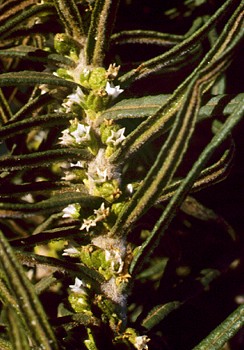
Synonymy
Symonanthus aromaticus (C.Gardner) Haegi, Telopea 2: 175 (1981)
Anthocercis aromatica C. Gardner, Hooker's Icon. Pl. ser. 5, 4: t. 3382 (1939).
T: Lake Cowan, Forrestania, W.A., Sept. 1929, C.A. Gardner 2650; holo: PERTH; iso: K, ADW (photo). Lake Cowan is probably an error for Lake Cronin.
Description
Woody shrub to 3 m; new shoots and leaf axils minutely pubescent.
Leaves narrowly elliptic to lanceolate; lamina 20–65 mm long, usually less than 30 mm wide; petiole up to 10 mm long.
Inflorescence terminal, panicle-like, congested; flowers numerous, sessile or on pedicels to 10 mm long, occasionally subtended by short bract. Calyx 3–5 mm long; lobes triangular, 1 mm long. Corolla greenish-yellow; tube narrow, 15–18 mm long; lobes 3.5–5 mm long. Stamens inserted near middle of corolla-tube; filaments 6–7 mm long, swollen and retrorsely pubescent in lower part; anthers 0.5–1 mm long. Style 17–18 mm long.
Berry oval-ovoid, 10–15 mm long, black. Seeds prismatic, 3.5–4 mm long, dark brown.
Distribution and ecology
Endemic to south-western W.A. in the south-eastern wheatbelt region.
Occurs as scattered populations in sandy soil, usually in disturbed habitats in mallee or woodland.
Notes
Phylogenetic studies by Garcia & Olmstead (2003) on the Tribe Anthocercideae using two chloroplast DNA regions included this species. The studies indicated that Symonanthus is monophyletic.
Reference: V.F.Garcia & R.G.Olmstead (2003). Phylogenetics of Tribe Anthocercideaea (Solanaceae) based on ndhF and trnL/F sequence data. Systematic Botany 28: 609-615.
Pharmacology
A discussion of the tropane alkaloids which occur in Symonanthus and other Anthocercideae can be found in Griffith & Lin (2000).
"Symonanthus aromaticus is chemically unique as the roots contain mono- and ditigloyl esters like Datura species. Both aerial parts and roots have scopolamine and its derivative aposcopolamine, as the main alkaloids."
Ref: W.J. Griffin & G.D. Lin (2000). Chemotaxonomy and geographical distribution of tropane alkaloids. Phytochemistry 53: 627–628.
Selected specimens
W.A.: c. 13 km NW of Newdegate, L. Haegi 1072 (AD, BRI, CANB, MO, PERTH); c. 12 km NW of Newdegate, L. Haegi 1820 (BIRM, BRI, CBG, CORD, F, MEL, MO, NSW, PERTH); c. 13 km N of Newdegate, 10 Oct. 1965, F. Humphreys (PERTH); Bald Rock, E of Hyden, N.G. Marchant 72/654 (PERTH).
Derivation of epithet
From the Latin, aromaticus, a reference to the aromatic foliage.
Images and information on web
Further information for this species in WA can be found on the FloraBase site.
Plant status (if any)
Without any declared rating in W.A. – see http://florabase.calm.wa.gov.au/conservationtaxa


